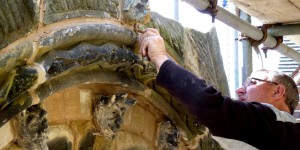The Roman Ridge, a substantial bank and ditch earthwork that commences in Sheffield, terminates at Mexborough. The Ridge is currently undated but is likely to have been constructed in the Iron Age, the early Romano-British period or the early medieval period. The purpose of the Roman Ridge remains unclear and the reason for its termination at Mexborough is unknown.
Early medieval activity in the area is indicated by place-name evidence, with Mexborough deriving its name from the Old English or Old Norse personal name ‘Meac’ or ‘Mjuk’ and the Old English ‘burh’, meaning a fortified settlement (Smith 1961). Mexborough appears to have been part of a system of fortified sites along the Dearne and Don valleys during the early medieval period (Hey 1979).
Mexborough’s proximity to the river crossing over the Don at Strafforth Sands is likely to have influenced the development of the burh, although the site of the fortified area is unclear. Early medieval elements are preserved within the fabric of the Church of St. John the Baptist, while a late 11th-century stone cross survives in the Lady Chapel.
Mexborough was granted to Roger de Busli, the lord of Tickhill, following the Norman Conquest. A motte and bailey castle was constructed at Castle Hill, probably during the late 11th century, while the area was the location for meetings of the Strafforth Wapentake court in this period. The village was granted to Monk Bretton Priory during the medieval period and was confiscated by the Crown at the Dissolution in the 1530s.
Mexborough remained a small village until the late 18th century, when the Don Navigation made the area viable for new industries, including deep coal mining, glass manufacture and pottery production. Mexborough Pottery opened on a site adjacent to the canal in 1800. The South Yorkshire Railway opened at Mexborough in 1850 and a National School was built by public subscription in 1865.
During the 19th century, the village’s industries included the Emerys Pottery, the Mexborough Rock Pottery, the Don Valley Pottery, the Phoenix Glass Works, the Bull Green Glass Works and the New Don Glass Works. Expansion to the west of the village in this period was so extensive that the area became known as ‘New Mexborough’. Several coal mines were sunk in the Mexborough region during the 19th and early 20th centuries, including Denaby Main Colliery and Cadeby Colliery.
Locations in the Dearne
All locations that are related to this content are as follows:


